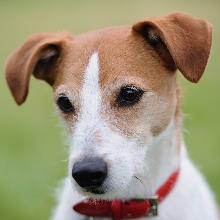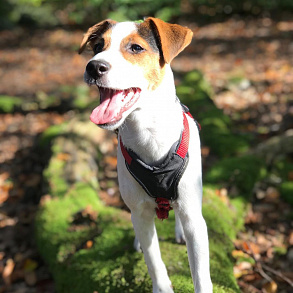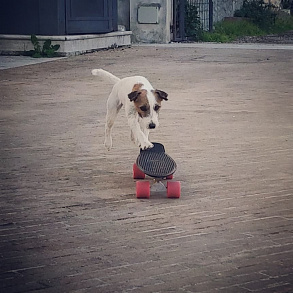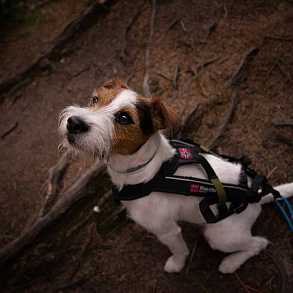Parson Russell Terrier

The Parson Russell Terrier is an English breed of small white–spotted dogs bred for burrowing fox and badger hunting.
- Brief information
- Highlights
- Breed characteristics
- History of the Parson-Russell Terrier breed
- Parson Russell Terrier Breed Standard
- Character of the Parson Russell Terrier
- Hunting with Parson Russell Terrier
- Education and training
- Maintenance and care
- Health and diseases of Parson-Russell Terriers
- How to choose a puppy
- Price of the Parson Russell Terrier
Brief information
- Breed Name: Parson Russell Terrier
- Country of Origin: UK
- Weight: 6-8 kg
- Height (height at the withers): 33-36 cm
- Life expectancy: 13-15 years old
Highlights
- The breed is common in European countries and is much less common in the USA.
- The closest relatives of the Parson Russells are Jack Russell Terriers. Once both breeds were one and interbred with each other, but then their representatives received separate standards. Now Parson Russell Terriers are bred mainly in the UK, and Jack Russell terriers are bred in Australia.
- In everyday life, representatives of this family are the greatest provocateurs who know how to bring even the most restrained dog to white heat.
- As born hunters, Parson-Russells are allowed to have "battle scars" at exhibitions, if they do not distort the breed appearance of the animal.
- High level of physical activity and playful nature make the breed unsuitable for elderly and sedentary owners.
- The hunting instinct of the "parsons" extends to any small animals, therefore, walking through the streets, get ready for live gifts obtained by the pet as a result of digging holes and flower beds.
- The Parson Russell Terrier quickly finds contact with children, but it can conflict with toddlers who have not yet learned how to properly handle animals.
- Once upon a time, the main competitor of Parson-Russels in the hunting profession were jack-Russels, who had shorter legs and moved more freely in fox and badger burrows. But in recent years, representatives of the second breed have slowed down and more often acquire exhibition than working diplomas.
Parson Russell Terrier is a first-class researcher of badger holes, an unsurpassed pied piper and an energetic athlete with a positive attitude to life. Like all representatives of the terrier group, he is a little reckless and easily gets involved in conflicts with larger dogs, but it is never boring with him. Moreover, if you are periodically attacked by melancholy and you do not know how to fill your own day, try to get a Parson-Russell. You can be sure that with such a pet there will simply be no time for longing, as well as for quiet weekends on the couch watching TV shows.
Breed characteristics
Video: Parson Russell Terrier
History of the Parson Russell Terrier breed
The Parson Russell Terrier is one of the few breeds in whose pedigree there are no white spots, despite the fact that its roots go back to the XVIII century. Moreover, history has preserved the name of the creator of the "parsons", who was the English pastor John Russell from Devon. In his youth, the monk loved hunting on horseback, so he set out to bring out a dog accompanying the rider on his trips for trophies.
As a basic breeding material, Russell chose terriers, which he initially tried to cross with other breeds. Soon the pastor got tired of tinkering with puppies who did not show any hope in the work plan, and he began knitting all kinds of terriers together in a row. The enthusiastic breeder did not dwell on the exterior of his own pets, preferring to pay attention to the hunting inclinations of litters, so the first "parsons" could not boast of an expressive and uniform appearance.
Until about the middle of the XX century, the Parson-Russells remained in the shadow of their more successful relatives in the group. Dogs were bred, hunted with them, but they were in no hurry to standardize. It is not known how long this disregard on the part of canine associations would have lasted if the Second World War had not broken out in Europe, during which Reverend Russell's dogs began to be exported to the USA and the countries of the Eurasian continent, which made them more popular.
However, the military actions had little effect on the formalities associated with entering the breed into the stud books, so for more than forty years the dogs did not have their own standard. The first step towards the registration of Parson Russell Terriers was taken by the English Kennel Club, which in 1990 developed a temporary appearance standard for the pastor's wards. At the same time, the official recognition of the FCI to the breed came only in 2001.
The standard of the Parson-Russell Terrier breed
Parson-Russells are very similar to jack russell terriers , which is no coincidence – the breeds have common progenitors, and until 2001 they generally had to share one standard of appearance for two. And yet there are exterior differences between representatives of both families. For example, "parsons" are slightly taller than "jacks" and have an almost square torso format, whereas their counterparts have a distinctly rectangular body. The length of the legs is also considered a breed trait. Parson Russell Terriers have more elongated limbs compared to stocky and compact ones jack russells .
Head
The skull of the Parson Russell Terrier is flat, moderately wide, slightly narrowed in the muzzle area. The stop is shallow, smooth.
Jaws and bite
Representatives of the breed have strong, well-developed jaw bones and an impeccable scissor bite.
Nose
The lobe is moderately developed, painted black.
Eyes
Parson Russell Terriers are characterized by deep-set almond-shaped eyes with a dark-colored iris. The dog's gaze is inquisitive, penetrating.
Ears
Ear cloth of small size, perfect triangular shape, hanging forward. The tips of the ears almost touch the outer corners of the eyes.
Neck
The neck of a purebred individual should be muscular and gradually expand towards the shoulder girdle. Pronounced massiveness of this part of the body is not welcome.
Housing
The Parson Russell Terrier has an almost square body with a strong back, a barely convex loin and a normal chest depth, located above or at the level of the dog's elbows.
Limbs
Parson-Russell's forelegs are straight, strong, with long backward-pointing shoulder blades and elbows tightly pressed to the body. The hind limbs are distinguished by muscularity and good articulation angles, while the hock joints of the legs are located very low. The animal moves with a flourish-freely, energetically.
Tail
Working Parson-Russell terriers have their tails docked, so it is possible to consider this part of the body in its natural form only in show individuals (cynological associations of Europe vetoed the cupping procedure). The natural tail should be perfectly straight, powerful, relatively high set, and keep upright in motion. The cropped tail should not be too short, so that, if necessary, the owner can grab it with his hand, extracting the pet from the fox hole.
Wool
The Parson Russell Terrier can be both slightly shaggy and smooth-haired. The coat itself is coarse and thick, which is a prerequisite for hunting breeds – a dense layer of hair protects the dog's body from bites and scratches of a wild animal.
Color
Parson-Russels are completely white or white with red, black and yellow spots. Moreover, it is preferable if the spots are located on the head or in the area of the base of the tail.
Defects and disqualifying vices
Individuals whose appearance does not fit into the framework set by the standard are considered defective. In particular, dogs with an incomplete set of teeth, an irregular structure of the body and paws, as well as with the iris painted in light colors, will be rejected by the exhibition judges or will receive a low rating. Animals with unstable mentality, as well as Parson-Russells with too conspicuous defects of appearance, indicating a dubious pedigree, are subject to complete disqualification.
Character of the Parson Russell Terrier
The Parson Russell Terrier looks like a little hurricane in dog form. These funny energetic minx are so restless in their adventures that in order to avoid trouble, their impulses have to be carefully restrained. As an example: for Parson-Russell, it is a sacred thing to bark at any, even the most formidable dog, not to mention cats, which must be immediately caught up and brought to a state of shock.
In the family, the pet behaves affably and emotionally, trying to participate in all the undertakings of the household. But it's better not to get introverts Parson-Russels – they won't sit in a corner, waiting for hours for the owner's call, spotted energizers. In extreme cases, they will start barking resentfully and boringly in an attempt to attract attention to themselves, or they will come up with a more sophisticated entertainment, as a result of which the owner will have to think about repairing the apartment and buying new furniture.
Due to their fervent and extremely curious nature, Parson-Russell Terriers easily join children's groups. By the way, it is children who become ideal companions for a dog that does not work for the beast – where else can an overstayed animal let off steam, if not in endless hide-and-seek! So if your young heirs have an idea of the rules for handling pets, periodically the "burden" of walking and entertaining a dog can be blamed on them.
The passion for digging up the land of Parson-Russell Terriers has not passed by, and there's nothing you can do about it. Moreover, sometimes representatives of the breed reach completely extreme actions. For example, the Internet is full of videos, the main characters of which are the Parson–Russells, digging up an imaginary treasure right in the center of a dirty puddle or a dung heap. However, there are advantages to this behavior: the chances of becoming a YouTube star and collecting millions of views from these white-haired "archaeologists" are high, like no other breed.
Hunting with Parson Russell Terrier
Unlike their cousins jack russells , "parsons" have not yet transformed into an exhibition and decorative breed, but all the prerequisites for this are available. For example, today very few people go with a terrier to a badger, fearing pet injuries, although there is still a pritravka on foxes. The breed has proven itself well in hunting wild boars – the miniature dimensions of Parson Russell Terriers are more than compensated by the viciousness to the beast, which has long been considered a mandatory attribute in the character of a hunting dog.
It turns out that the Parson-Russells also work in dense bushes, as well as stand "on the feed" of the wounded animal and bird. And yet the real element of terriers is burrows. It is in them that animals feel especially at ease. So if you plan to go with your pet to foxes and raccoons, take a course of pritravki in artificial burrows, which are equipped in many hunting clubs. Another plus of the "parsons" is mobility. It is convenient to transport such small dogs over long distances, and the animals themselves willingly travel for the company of their owner.
In general, the Parson Russell Terrier does not need long-term hunting training - the dog is able to get a small animal even without preliminary priming. You can verify this by talking with the breeders of the breed. Almost every one of them has a dozen stories in store about how Parson-Russell returned from a walk either with a garbage rat, or with a mole dug out of a hole. So in most cases, the essence of the training of a four-legged miner is reduced to teaching discipline and working contact with the owner.
Education and training
Paradoxically, the little Parson Russell Terrier is prone to dominance, so it is important not to miss and stop the moment when the dog feels the "big boss" in himself. To do this, after moving the puppy to a new apartment, you will have to clearly outline the boundaries of what is allowed. In particular, no matter how affectionate and funny Parson-Russell is, he has no right to occupy your bed – the dog has its own place in the house, and it should sleep only there. Begging and sharp attacks should be stopped immediately, because this is nothing more than a cunning test of the authority and compliance of the owner.
Never put a pet in the front seat of a car, thereby equating the animal with yourself. The breed loves traveling, but even more loves to "steer", both by vehicle and by person. On walks, the Parson Russell Terrier will also have to instill norms of etiquette. Of course, it will not be possible to wean the dog from ruining flower beds and hunting moles, but it is certainly worth banning large aggressive dogs from barking and bullying with them, if the life of a pet is dear.
Teams will have to tinker with Parson-Russell training, so if training is tight, you can make yourself and your pet a little relaxation and stop at the simplified UGC course. This baggage of knowledge is enough to safely take the dog to the noisy city streets. By the way, even pretending to be a universal goody-goody Parson-Russell Terrier is categorically contraindicated to let off the leash in open spaces. Otherwise, you will be looking for a four-legged traveler for a very long time.
Maintenance and care
Parson-Russell terriers are not bought "on the sofa". Ideally, a dog should work like a beast or at least lead an active sports life in order to realize its own instincts. As for the content, the breed can be placed both in the house and in the apartment. Moreover, if we are talking about a cottage with a fenced yard, it is also worth taking care of the safety of the animal – the Parson Russell terrier does not cost anything to dig under the fence and go on exploits in the nearest forest belt. Low fences are also not a problem for the breed: "parsons" are incredibly jumpy and if they set themselves a goal to jump over an obstacle, they will definitely achieve what they want.
Walking for Parson Russell Terriers is a vital necessity. Puppies are recommended to be taken outside four times a day, which is partly due to toilet needs: babies are not able to endure for a long time. An adult "parson" will have enough for a couple of walks a day, but it should be long promenades with active games, running, digging and other terrier joys.
Hygiene
The amount of time allocated to pet care directly depends on how your type of Parson Russell Terrier is smooth-haired or shaggy. In the first case, everything is extremely simple: walk once a week on the dog's "fur coat" with a soft brush or a damp terry towel and collect dead hairs and dust particles. But with a wire-haired "parson" you will have to comprehend the basics of stripping (manual plucking of wool) or trust a pet to a professional groomer, which is quite expensive.
On average, pets are trimmed every six months, although show animals are recommended to undergo this procedure at least once every three months. The first pinch is done when the puppy is five months old. But it is not recommended to cut shaggy Parson-Russell Terriers to give them a neater look. Even if the animal never goes to the exhibition, the scissors will only worsen the situation and change the structure of the coat – the hard hair of the dog will become softer, plumper and cease to perform a protective function. For this reason, it is possible to cut wool exclusively for hygienic purposes. For example, between the fingers or in the anal area.
Weekly ear cleaning, eye rubbing with chamomile infusion in the morning, nail clipping are mandatory procedures in the life of every Parson Russell Terrier. The oral cavity of the animal also needs constant inspection and hygiene. The standard mode of brushing a dog's teeth is twice a week. In addition, periodically the dog needs to be given treats that remove plaque from the tooth enamel. It can be either tomato juice or vein bones from an animal store.
Feeding
On the one hand, all kinds of lean meat are useful for "parsons", and on the other hand, the body of these restless comrades can be terribly capricious about food. In particular, many representatives of the breed have a terrible allergy to chicken, and this is not treated. In addition to meat, Parson Russell Terriers are allowed to be fed with cheaper products. For example, tripe, liver, cartilage and other animal waste. Buckwheat, rice and oatmeal are useful from cereals; carrots, pumpkin, beets are useful from vegetables; apples are useful from fruits.
Egg yolk and low-fat dairy products should also be included in the menu. The main thing is not to overdo it and not to feed the pet daily with kefir and eggs, since there is no benefit from such an abundance. It is much more reasonable to use these products as an additive. For example, apple and carrot salads seasoned with sour cream are useful for Parson-Russels.
From the age of two months, vitamin and mineral complexes are included in the dog's diet: fish oil, calcium, chondroitin. And it will be better if the right mineral composition is selected by a veterinarian. As a reward during training, it is recommended to use hard cheese, rye crackers or dried apples, but in limited quantities.
Taboo products for Parson Russell terriers remain:
- semolina;
- citrus;
- grapes;
- sweets;
- smoked and sausage products;
- mushrooms, nuts;
- corn in any form;
- onion, pepper, garlic.
The Parson Russell Terrier is a small and ultra-energetic dog, but this does not mean that it needs to be constantly fed. Healthy adults eat twice a day, and this is quite enough. The daily norm of food for a pet should be 7-10% of its weight, but the number of meals directly depends on age. Up to four months, a puppy brought from the kennel is fed 5 times a day – during this period, the baby is actively gaining muscle mass and needs protein and calories. At the age of six months, it is more expedient to transfer "Parson" to four meals a day. At 10-12 months, a three-meal meal is enough for a dog, and after a year, the animal can be transferred to an "adult table" without any reservations, that is, fed twice a day.
Health and diseases of Parson-Russell Terriers
The "parsons" and "jacks" have a common bouquet of diseases, and quite serious ones. For example, representatives of both breeds suffer from hereditary dysplasia of the joints, so when buying a puppy in a kennel, ask the seller if his producers have been examined for the presence of this ailment. In addition to dysplasia, Parson-Russell Terriers are susceptible to various types of arthritis and Perthes' disease, and this is at least a loss of hunting qualifications for animals, and at most a complete disability.
Congenital deafness is another scourge of the Parson–Russell family, and, oddly enough, the coat color is to blame for this: according to statistics, most deaf puppies have white "fur coats". At an early age, it is extremely difficult to notice deafness in terriers, since the breed has a phenomenal sense of smell and hearing defects do not prevent it from being perfectly oriented in space. For this reason, it is better to entrust the case to a veterinarian who will conduct tests to detect deafness and make the right verdict.
The organs of vision of the "parsons" need close attention. Such a pathology as the "collie's eye" can provoke cataracts, and then complete blindness of the dog. This disease is not treated, and the only thing that can be done in such cases is to examine a puppy that has not had time to grow up and stop the development of the disease, partially preserving vision. Parson-Russell Terriers are familiar with allergies and even diabetes, which obliges owners to be extremely careful when drawing up a natural pet menu.
How to choose a puppy
- Before you go to the nursery, decide which line representative you need. Show animals need to be bought from a breeder who travels with his own producers to exhibitions, and working puppies - from breeders engaged in natasha and taking their wards out to hunt.
- Newborn Parson Russell Terriers are very similar to jack russells , therefore, in order to avoid deception by an unreliable seller, it is better to wait until the animal is 8-9 months old.
- When choosing "Parson" as a pet, pay attention to his behavior. Overly assertive and striving to grab a stranger by the trousers, puppies are good for hunting, but not for living in the same apartment with young children.
- The dominant coat color of the Parson Russell Terrier is white (at least 70% of the body should be colored in this tone). If you are offered overly spotted puppies, this is a plembrak.
- Pay attention to the puppy's movements. They should be linear and well-coordinated. An uncertain gait, a slight limp, trembling and a shaking head are signs that the animal is unhealthy.
- Study the pedigrees of the parents of the Parson Russell Terrier you like and make sure that they are not littermates.
- Specify the possibility and timing of the return of the puppy to the breeder in case something does not suit you. This gives you a chance to take your baby to a veterinarian on your own to check his health and identify genetic diseases.
Price of Parson Russell Terrier
A few years ago, even the most upscale Parson was cheaper than its Australian cousin jack russell , but today the prices for representatives of both breeds are about the same. In particular, Parson Russell Terrier puppies from parents with exhibition and working diplomas are sold at $300 – $400. Offspring from less famous ancestors, but with a full package of documents and vaccinations will cost $200 – $250. Sometimes you can buy an average pet for $150, but in this case there is a high probability of getting a puppy with hereditary pathologies. Most breeders who sell Parson Russell Terriers at prices below the average market are not spent on expensive veterinary examinations.


